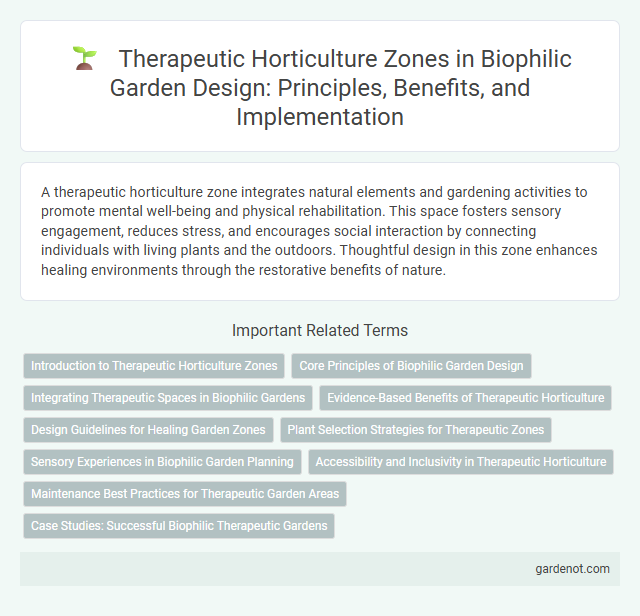A therapeutic horticulture zone integrates natural elements and gardening activities to promote mental well-being and physical rehabilitation. This space fosters sensory engagement, reduces stress, and encourages social interaction by connecting individuals with living plants and the outdoors. Thoughtful design in this zone enhances healing environments through the restorative benefits of nature.
Introduction to Therapeutic Horticulture Zones
Therapeutic horticulture zones are specialized outdoor or indoor spaces designed to promote mental and physical well-being through interaction with plants and gardening activities. These zones incorporate elements such as raised garden beds, sensory plants, and accessible pathways to accommodate diverse user needs and enhance therapeutic outcomes. Research shows that engaging with therapeutic horticulture zones can reduce stress, improve mood, and support cognitive function in individuals across various age groups.
Core Principles of Biophilic Garden Design
Therapeutic horticulture zones embody the core principles of biophilic garden design by integrating natural elements that promote sensory engagement, stress reduction, and mental restoration. These spaces prioritize direct interaction with diverse plant species, natural materials, and water features to enhance emotional well-being and cognitive function. Incorporating fractal patterns, organic shapes, and dynamic natural light fosters a multisensory environment that supports healing and connection to nature.
Integrating Therapeutic Spaces in Biophilic Gardens
Integrating therapeutic horticulture zones within biophilic gardens enhances mental and physical well-being by fostering direct interaction with nature. These spaces utilize sensory-rich plants, adaptive gardening tools, and calming water features to stimulate healing and mindfulness. Evidence from healthcare design research shows that biophilic therapeutic gardens reduce stress, improve mood, and accelerate patient recovery times.
Evidence-Based Benefits of Therapeutic Horticulture
Therapeutic horticulture zones harness the healing power of nature to improve mental health by reducing stress, anxiety, and depression, supported by numerous peer-reviewed studies. Engaging in gardening activities enhances cognitive function, promotes social interaction, and accelerates physical rehabilitation, making it a valuable intervention in healthcare settings. Research from institutions such as the American Horticultural Therapy Association demonstrates measurable improvements in patient well-being, including lowered cortisol levels and increased serotonin production.
Design Guidelines for Healing Garden Zones
Therapeutic horticulture zones in healing gardens prioritize accessibility, sensory engagement, and restorative landscapes to promote physical and mental well-being. Design guidelines emphasize raised planting beds, non-toxic and fragrant flora, as well as seating areas that encourage relaxation and social interaction. Integrating wheelchair-accessible pathways and water features enhances multisensory stimulation and supports therapeutic outcomes.
Plant Selection Strategies for Therapeutic Zones
Selecting plants for therapeutic horticulture zones requires prioritizing species with proven psychological and physiological benefits, such as Lavandula angustifolia for stress reduction and Rosmarinus officinalis to enhance cognitive function. Emphasizing biodiversity, plants with varied textures, colors, and scents like Achillea millefolium and Mentha piperita promote sensory stimulation and engagement. Native, low-maintenance, and non-toxic species optimize safety and sustainability while supporting local ecosystems within therapeutic environments.
Sensory Experiences in Biophilic Garden Planning
Therapeutic horticulture zones in biophilic garden planning emphasize multisensory experiences to enhance well-being and cognitive function. Incorporating diverse plant species with varying textures, scents, and colors stimulates tactile, olfactory, and visual senses, creating immersive environments that reduce stress and improve mood. Strategically designed sensory pathways and interactive planting beds foster engagement, promoting physical activity and mindfulness within natural settings.
Accessibility and Inclusivity in Therapeutic Horticulture
Therapeutic horticulture zones prioritize accessibility by incorporating raised garden beds, wide pathways, and adaptive tools tailored for users with mobility challenges or sensory impairments. Inclusive design features such as multi-sensory plant selections and adjustable planting stations support diverse physical and cognitive abilities, fostering engagement for individuals with disabilities. These elements ensure therapeutic benefits by creating equitable, user-centered environments that promote healing, relaxation, and social interaction.
Maintenance Best Practices for Therapeutic Garden Areas
Therapeutic horticulture zones require regular inspection to ensure plant health and safety, with pruning, weeding, and soil conditioning performed consistently to maintain optimal growth conditions. Utilizing organic fertilizers and integrated pest management minimizes chemical exposure, supporting both plant vitality and user wellbeing. Clear pathways and durable, accessible features enhance usability, fostering a safe and restorative environment for therapeutic activities.
Case Studies: Successful Biophilic Therapeutic Gardens
Therapeutic horticulture zones in successful biophilic therapeutic gardens demonstrate significant improvements in patient well-being, cognitive function, and stress reduction. Case studies from facilities like the Royal Melbourne Hospital and Singapore's Khoo Teck Puat Hospital reveal enhanced recovery rates and increased patient engagement when natural elements and interactive plant-based activities are integrated. These gardens utilize multisensory stimulation, seasonal plant diversity, and accessible layouts to foster healing environments that connect users with nature.
Therapeutic horticulture zone Infographic

 gardenot.com
gardenot.com